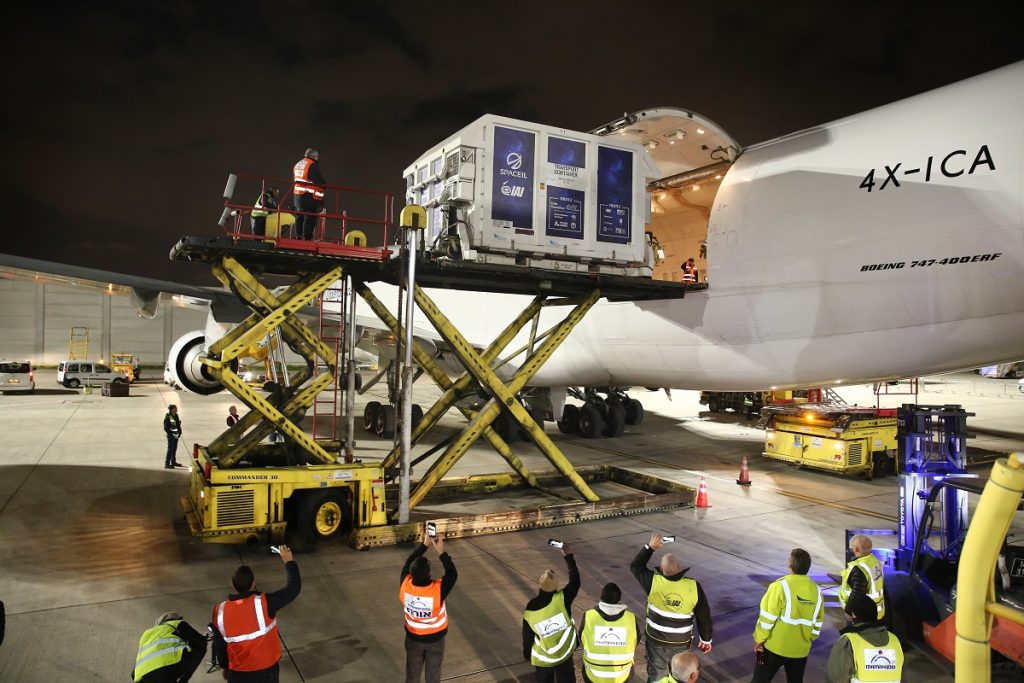SpaceIL’s spacecraft arrived in Cape Canaveral, Florida late last week ahead of its expected trip to the moon from SpaceX Launch Complex 40 (SLC-40) next month.
The 180-kilogram lunar spacecraft was transported by cargo plane from Ben-Gurion International Airport on Thursday in a special temperature-controlled, sterile shipping container and made its way to Orlando International Airport, after which it was taken to Cape Canaveral Air Force Station.
The spacecraft will be added as a secondary payload by launch service provider Spaceflight and will be launched on a SpaceX Falcon 9 rocket together with a geostationary communications satellite built by SSL sometime in mid-February.
SpaceIL and Israel Aerospace Industries engineers accompanied the spacecraft on the flight to Florida and will be joined by more engineers as the spacecraft, dubbed “Beresheet” (Genesis), undergoes final tests before the expected launch.
“After eight years of hard work, our dream has come true: We finally have a spacecraft,” said SpaceIL CEO Ido Anteby in a statement. “Shipping the spacecraft to the United States is the first stage of a complicated and historic journey to the moon. This is the first of many exciting moments, as we look forward to the forthcoming launch in Cape Canaveral.”
If SpaceIL is successful, Israel will become the fourth country — after the US, Russia, and China — to complete a controlled lunar landing.
Beresheet is carrying a digital time capsule loaded with Hebrew songs, stories, Israel’s Declaration of Independence and national anthem, among other national symbols.
Sign up for our free weekly newsletter
SubscribeThe time capsule, along with the spacecraft, is set to remain on the moon indefinitely. With no plans to return to Earth, the spacecraft and information within the time capsule’s disks could be found by future generations, SpaceIL previously said in a statement.
SpaceIL was founded in 2010 by engineers Yariv Bash, Kfir Damari and Yonatan Weintraub, as part of a mission to take part in the Google Lunar X competition which came with a prize of $20 million. SpaceIL entered the race in 2012 and became the first international team in 2015 to sign a contract with aerospace manufacturer SpaceX and have its financial and technical details approved by the contest.
The original competition involved placing a spacecraft on the moon’s surface, traveling 500 meters on the moon, and transmitting high-definition video and images back to Earth. The winner would have won $20 million and the second-place team would have nabbed $5 million.
Israel was one of five finalists in the final stage and was competing against four other teams: Moon Express (USA), Synergy Moon (an international collaboration of 15 countries), TeamIndus (India) and HAKUTO (Japan).
The March 2018 deadline came and went and the prize went unclaimed. But SpaceIL vowed to maintain its efforts to put Israel on the moon, arguing that its motivation was not the money, but about “showing the next generation that anything is possible – that even our small country can push the limits of imagination,” Anteby said in March.
Related posts

Israeli AI Safety Tool Among TIME’S Best Inventions For 2024

TAU Team Discovers Mechanism To Eliminate Cancerous Tumors

Ashdod Port Investing In Startups As Part Of Innovation Strategy




Facebook comments